|
February 1947 Radio-Craft
 [Table of Contents] Wax
nostalgic about and learn from the history of early electronics. See articles
from
Radio-Craft, published 1929 - 1953. All copyrights are hereby acknowledged. [Table of Contents] Wax
nostalgic about and learn from the history of early electronics. See articles
from
Radio-Craft, published 1929 - 1953. All copyrights are hereby acknowledged. |
Here is yet another example
of how hobbyists laid the groundwork for technical innovations that were
eventually adapted for use and improved by professional organizations - the
military, universities, corporations. Radio control of model airplanes was first
successfully achieved by a pair of brothers,
Dr. Bill Good and
Dr. Walt Good (kind of like the Wrights), who experimented with what
were at the time rather crude engines and electronic and electromechanical
devices. The year was 1936, only eleven years before this article appeared in
Radio−Craft magazine reporting on the U.S. Army Air Force's and Navy's use of
radio-controlled drones, or as the title says, "Teleguided Missiles." Some
systems were designed from the ground up to be missiles while others were
systems installed in existing aircraft which had been decommissioned for normal
human-piloted use. They were sort of a
Kamikaze craft without the
expendable airman inside.
Teleguided Missiles
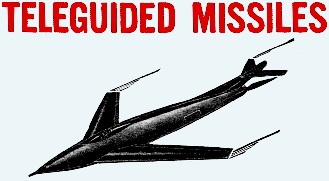
U.S.A.A.F. Photo
Model of a projected supersonic rocket-propelled
radio-controlled plane of the future.
By James A. Niland*
No example of American technical ingenuity is more spectacular than aircraft
remote control. Begun as a plaything, it has been perfected by wartime research
and now as a weapon of war it may greatly revise tactical and theoretical military
thought. In common with other inventions developed primarily for war, it also will
have valuable civilian use.
Army Air Forces because of their suitability as targets. The use of radio-controlled
airplanes early interested the
Sleeve
targets towed behind other aircraft only partially
performed their function: they were unrealistic and presented a hazard to the pilot
of the towing aircraft, often at the mercy of an unskilled marksman.
A target aircraft, on the other hand, realistic in every detail and controlled
by a pilot in another plane hovering at a safe distance, could create the proper
illusion. It could supply to the airborne machine gunner, as well as the anti-aircraft
gunner on the ground, with a maneuvering target to spur him on to his best efforts.
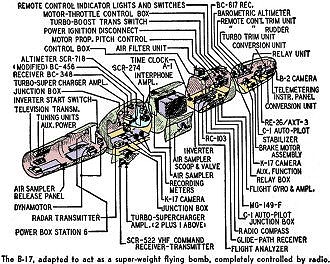
The B-17, adapted to act as a super-weight flying bomb, completely
controlled by radio.
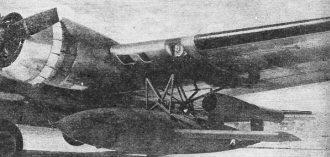
The JB-2 "buzz-bomb" under the wing can be radio-controlled for
a flight of 150 miles.
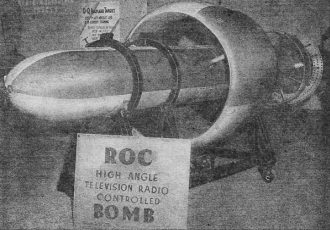
The ROC televises a view of the target back to its control, who
guides it accordingly.
The flight-testing of new aircraft too often has seen a plane go into a power
dive out of which the pilot was unable to level off. Crashing to earth the life
of the pilot was not the only loss suffered. The reason for the crash often remained
a mystery, concealed in the shattered fragments of the plane and the dead brain
of the pilot.
Today, plans can be test-flown without pilots aboard. The most difficult flight
maneuvers are accomplished by radio direction; with the reactions of the plane telemetered
to the ground as they occur. If the airplane crashes, the reason is no longer secret.
Valuable data has been gathered and recorded and serves as the basis for improvements
in subsequent models.
During the war the Army Air Forces loaded war-weary B-17 Flying Fortresses with
high explosives and purposely crashed them into high-priority German targets. Naturally
no pilots were aboard. The pilotless American Kamikazes were radio-directed to their
destinations by other B-17's. At that time the remote control system was not developed
sufficiently to get the planes off the ground by radio. Token crews took the planes
up and parachuted to safety as soon as the control planes took over.
The airplanes that flew through the atomic cloud at Bikini were controlled entirely
by radio; and the data their instruments gathered has contributed to scientific
knowledge of radiation. Later, two of the planes that were used at Bikini were,
flown 2,600 over-water miles from Hawaii to California. Arriving off Santa Rosa
Island, one of the planes dropped a smoke bomb. The flight of these two B-17's was
radio-controlled from start to finish.
The various setups in which remote control may be applied to aircraft are basically
similar. The channel of communication between the controlled and controlling airplanes,
known as the drone and mother respectively, is a specially designed transmitter
and receiver system. Controls on the drone are operated by servo motors either through
the airplane's automatic pilot, or directly from the transmitter. The servo motors
are activated by radio impulses in accordance with the desires of the controlling
pilot. Practically any maneuver within the capabilities of the plane may thus be
accomplished.
A two-view television set in the drone is trained both on the aircraft's instrument
panel and the outside atmosphere. By flipping a switch the controlling pilot may
visually examine important dials and gages, as if he were actually in the pilot's
seat of the drone.
The brains of the radio control system are incorporated in an ingenious five-pound
box, known as the beeper, because of the bird-like sounds it emits when in use.
See illustration in "Radio Target Planes," Radio-Craft, January, 1945. Levers on
the box allow for any combination of plane functions, such as throttle control,
raising and lowering flaps, etc.
While the range of control varies with conditions affecting radio reception,
control can be achieved up to a distance of 75 miles. Usually the take-off of the
drone is supervised by an operator in a jeep-installed ground station. After the
drone is airborne and has climbed to an altitude of about 400 feet the mother plane
takes over.
Under normal circumstances the drone's altitude is automatically controlled by
altimeter equipment specially installed for that purpose. However, the altimeter
setting may be overridden, when necessary, by a special relay box. The receiver-selector
in the drone includes an eight-channel audio filter selector circuit to discriminate
between the various tones received. A relay unit passes control voltages to the
automatic pilot from the receiver output.
Electronics is also playing an ever-increasing part in both jet-propelled and
glide missiles.
February, 1943, saw the first practical test of glide bombs (an ordinary bomb
fitted with wing surfaces) against a target in warfare; 58 B-17's launched 116 GB-1
glide bombs over Cologne, Germany. They were released several miles from the target
and guided to their destination by radio impulses sent out from the releasing planes.
The glide bombs were thus directed to the target without the necessity of the bombers
getting into the danger zone of anti-aircraft fire.
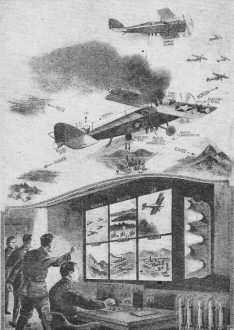
Reproduction of the page which showed the proposed television
plane.
Improvements constantly were made in radio-controlled glide bombs. Drop bombs
were fitted also with a special tail assembly that contained a built-in radio unit
which through servo units could control the angle of free fall of these bombs by
varying the slipstream over the rudder surfaces. This free-falling bomb was called
the Azon bomb, indicating it was controllable in azimuth only.
Colonel Harvey T. Alness and his 7th Bomb Group used this bomb during the spring
of 1945 to knock out the Japanese supply railroad running between Burma and Siam.
Another electronic missile, designated Felix, had a heat-sensitive electronic
unit located in its nose, which by electrical impulses operating on the tail miles
from the target and guided to surfaces guided the missile in its free fall to a
target that was emitting heat - such as a steelmill or a blast furnace.
The Razon bomb, an improvement over the Azon, was controllable by electrical
impulses both in azimuth and range. It had a gyro stabilizer which kept it from
turning in the air during the period of fall. The tail unit had four elevators or
rudders which permitted this double control.
One of the latest developments in free-falling missiles, the standard 1,000-pound
bomb known as Roc is fitted with a television scanner in its nose. The ground area
that the bomb scans during its free fall is televised back to the bomb-releasing
plane, thereby enabling the bombardier to guide Roc to its target by means of radio
impulses. Differing from all other free-falling missiles, Roc utilizes a circular
airfoil which can be tipped at different angles by radio impulses, thus changing
the angle of fall.
In the field of radio-controlled jet-propelled missiles is the German V-2 rocket,
which was used largely in the latter months of World War II in Europe for attacks
on England, Belgium, and Holland. This missile has a complicated electronic control:
there are radio-controlled carbon deflectors at the mouth of the rocket engine which
control the blast angle during take-off and acceleration, and rudders located at
the end of the four stabilizing vanes guide the rocket after the jet motor has ceased
to function, which is 63 seconds after ignition.
There is no field of either free-falling drop missiles or jet-propelled missiles
in which electronics does not play an ever-increasing and important part, and undoubtedly
this will continue to hold in the future. Recently charged with the responsibility
for all War Department investigation of guided missiles, the AAF is subjecting new
developments in this field to exhaustive evaluation.
(It is interesting to note that a completely remote-controlled plane incorporating
television was proposed by Hugo Gernsback more than twenty years ago in his magazine,
The Experimenter, November, 1924. The illustration reproduced with this article
is from that issue. Camera tubes were to be pointed in the six cardinal directions,
each transmitting the view it picked up to the control headquarters, where all the
images were to be projected on a single screen, giving the commanding officer a
complete view of the whole scene of action. Television reconnaissance planes were
actually used to some extent in the Pacific theater, and a demonstration of Block
and Ring airborne reconnaissance television was given at Washington last year. [Radio-Craft,
May, 1946]. Television was also used on the Roc, to transmit the scene ahead of
it and thus permit the control operator to guide it accurately to its target. -
Editor)
*Information and Public Relations, Headquarters Army Air Forces, New York, N.
Y.
Posted February 5, 2022
|